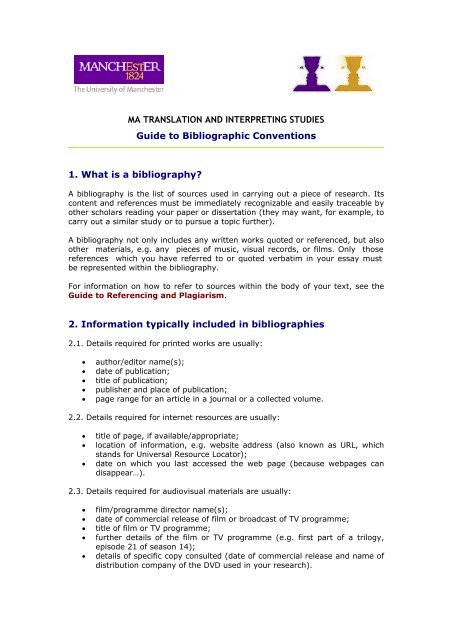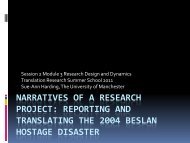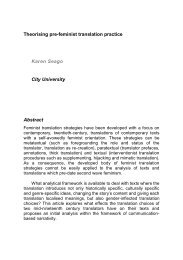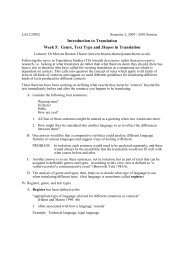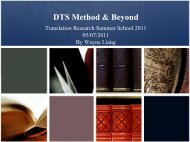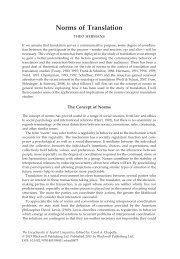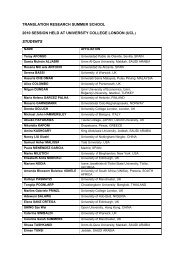MA TRANSLATION AND INTERPRETING STUDIES Guide to ...
MA TRANSLATION AND INTERPRETING STUDIES Guide to ...
MA TRANSLATION AND INTERPRETING STUDIES Guide to ...
You also want an ePaper? Increase the reach of your titles
YUMPU automatically turns print PDFs into web optimized ePapers that Google loves.
<strong>MA</strong> <strong>TRANSLATION</strong> <strong>AND</strong> <strong>INTERPRETING</strong> <strong>STUDIES</strong><br />
<strong>Guide</strong> <strong>to</strong> Bibliographic Conventions<br />
1. What is a bibliography<br />
A bibliography is the list of sources used in carrying out a piece of research. Its<br />
content and references must be immediately recognizable and easily traceable by<br />
other scholars reading your paper or dissertation (they may want, for example, <strong>to</strong><br />
carry out a similar study or <strong>to</strong> pursue a <strong>to</strong>pic further).<br />
A bibliography not only includes any written works quoted or referenced, but also<br />
other materials, e.g. any pieces of music, visual records, or films. Only those<br />
references which you have referred <strong>to</strong> or quoted verbatim in your essay must<br />
be represented within the bibliography.<br />
For information on how <strong>to</strong> refer <strong>to</strong> sources within the body of your text, see the<br />
<strong>Guide</strong> <strong>to</strong> Referencing and Plagiarism.<br />
2. Information typically included in bibliographies<br />
2.1. Details required for printed works are usually:<br />
• author/edi<strong>to</strong>r name(s);<br />
• date of publication;<br />
• title of publication;<br />
• publisher and place of publication;<br />
• page range for an article in a journal or a collected volume.<br />
2.2. Details required for internet resources are usually:<br />
• title of page, if available/appropriate;<br />
• location of information, e.g. website address (also known as URL, which<br />
stands for Universal Resource Loca<strong>to</strong>r);<br />
• date on which you last accessed the web page (because webpages can<br />
disappear…).<br />
2.3. Details required for audiovisual materials are usually:<br />
• film/programme direc<strong>to</strong>r name(s);<br />
• date of commercial release of film or broadcast of TV programme;<br />
• title of film or TV programme;<br />
• further details of the film or TV programme (e.g. first part of a trilogy,<br />
episode 21 of season 14);<br />
• details of specific copy consulted (date of commercial release and name of<br />
distribution company of the DVD used in your research).
<strong>Guide</strong> <strong>to</strong> Bibliographic Conventions<br />
3. Presenting bibliographical information at the end of your<br />
essay/dissertation<br />
Bibliographical information is presented in an alphabetically ordered list at the<br />
end of your work (essay, dissertation), in accordance with the following specific<br />
guidelines.<br />
As a rule, you should keep the layout as clean as possible. Do not be tempted, for<br />
example, <strong>to</strong> use the au<strong>to</strong>matic bulleting facility in Word, or put names in bold, etc.<br />
The cleaner the bibliography the easier it is for others <strong>to</strong> consult.<br />
Case 1: Single-authored book<br />
Up<strong>to</strong>n, Carole-Anne (2000) Moving Target: Theatre translation and cultural<br />
relocation, Manchester: St Jerome Publishing.<br />
• Things <strong>to</strong> note: use of capitals is different in title and subtitle. Use of<br />
italics for title of book.<br />
Case 2: Book with more than one author<br />
Hatim, Basil and Ian Mason (1997) The Transla<strong>to</strong>r as Communica<strong>to</strong>r,<br />
London and New York: Routledge.<br />
• Things <strong>to</strong> note: order of first name and surname is not inverted for<br />
second author.<br />
Case 3: Book with one edi<strong>to</strong>r<br />
Hermans, Theo (ed.) (2002) Cross-cultural Transgressions. Research<br />
models in translation studies II: His<strong>to</strong>rical and ideological issues,<br />
Manchester: St Jerome.<br />
Case 4: Book with more than one edi<strong>to</strong>r<br />
Bowker, Lynne, Michael Cronin, Dorothy Kenny and Jennifer Pearson (eds)<br />
(1998) Unity in Diversity: Current trends in translation studies,<br />
Manchester: St Jerome.<br />
• Things <strong>to</strong> note: ‘ed.’ has full s<strong>to</strong>p <strong>to</strong> denote abbreviation but ‘eds’ does<br />
not.<br />
Case 5: Publication with non-English title<br />
Helbig, Gerhard and Joachim Buscha (1988) Kurze deutsche Grammatik<br />
für Ausländer [Short German Grammar for Foreigners], Leipzig: VEB<br />
Verlag Enzyklopädie.<br />
• Things <strong>to</strong> note: non-English title is glossed in square brackets.<br />
Different conventions for capitalisation are applied for the foreign<br />
language and for English.<br />
Centre for Translation and Intercultural Studies Page 2 of 5
<strong>Guide</strong> <strong>to</strong> Bibliographic Conventions<br />
Case 6: Article in journal<br />
Taylor, Chris<strong>to</strong>pher (2003) ‘Multimodal Transcription in the Analysis,<br />
Translation and Subtitling of Italian Films’, The Transla<strong>to</strong>r 9(2): 191-205.<br />
• Things <strong>to</strong> note: title of article in inverted commas. Title of journal in<br />
italics. Volume 9, Number 2 given as 9(2). Page range follows issue<br />
number. No publisher or place of publication given.<br />
Case 7: Article in collected volume (i.e. in edited book)<br />
Gentzler, Edwin (1998) ‘How Can Translation Theory Help<br />
Undergraduates’, in Peter Bush and Kirsten Malmkjær (eds) Rimbaud’s<br />
Rainbow, Amsterdam and Philadelphia: John Benjamins, pp. 21-31.<br />
• Things <strong>to</strong> note: Order of first name and surname for edi<strong>to</strong>rs. Page<br />
range preceded by 'pp.' Note also that an article in a collected volume<br />
is always listed under the name of its author, not the name of the<br />
edi<strong>to</strong>rs of the collected volume.<br />
Case 8: Books with more than one edition<br />
Cook, Guy (1992/2001) The Discourse of Advertising, London and New<br />
York: Routledge, 2nd edition.<br />
Case 9: More than one work by the same author<br />
Fawcett, Peter (1995) ‘Translation and Power Play’, The Transla<strong>to</strong>r 1(2):<br />
177-92.<br />
------ (1997) Translation and Language: Linguistic theories explained,<br />
Manchester: St Jerome.<br />
Case 10: More than one work by the same author published in the same<br />
year<br />
Stubbs, Michael (1995a) ‘Collocations and Semantic Profiles: On the cause<br />
of the trouble with quantitative studies’, Functions of Language 2(1): 23-<br />
55.<br />
------ (1995b) ‘Collocations and Cultural Connotations of Common Words’,<br />
Linguistics and Education 7: 379-90.<br />
• Things <strong>to</strong> note: Works labelled ‘a’ and ‘b’. You can write ‘379-90’<br />
instead of repeating all digits, i.e. instead of writing ‘379-390’.<br />
Case 11: An entire journal issue, e.g. a special issue or an issue with a<br />
guest edi<strong>to</strong>r<br />
Vandaele, Jeroen (ed.) (2002) Translating Humour, Special Issue of The<br />
Transla<strong>to</strong>r, 8(2).<br />
Centre for Translation and Intercultural Studies Page 3 of 5
<strong>Guide</strong> <strong>to</strong> Bibliographic Conventions<br />
Case 12: A dictionary or encyclopedia<br />
Scholze-Stubenrecht, W. and J. B. Sykes (eds) (1997) The Oxford-Duden<br />
German Dictionary: Revised Edition, Oxford: Clarendon Press.<br />
• Things <strong>to</strong> note: Occasionally no edi<strong>to</strong>rs are given for reference works.<br />
Where this is the case, start your entry with the title of the reference<br />
work (in italics), then the date, then the publication place and<br />
publisher. For example:<br />
Collins English Dictionary (1991) Glasgow: HarperCollins.<br />
Case 13: An entry in an Encyclopedia<br />
House, Juliane (1998) ‘Quality of Translation’, in Mona Baker (ed.)<br />
Routledge Encyclopedia of Translation Studies, London & New York:<br />
Routledge, pp. 197-200.<br />
Case 14: An article in a publication with no edi<strong>to</strong>r and/or no<br />
publisher/place of publication (e.g. some conference or workshop<br />
proceedings)<br />
Zanettin, Federico (2002) ‘Corpora in Translation Practice’, LREC 2002<br />
Workshop: Language Resources for Translation Work and Research,<br />
Workshop Proceedings, pp. 10-14.<br />
Case 15: A report issued by an organisation, with no edi<strong>to</strong>r or publisher<br />
Siemens AG (2004) Annual Report 2004.<br />
Case 16: A website<br />
Siemens website: http://www.siemens.com/ [last accessed 1 September<br />
2006].<br />
Lexicool website: http://www.lexicool.com/ [last accessed 1 September<br />
2006].<br />
• Things <strong>to</strong> note: these websites can be identified by the company name<br />
and these references are therefore <strong>to</strong> the whole website. Always give a<br />
‘last accessed’ date.<br />
Case 17: A specific page or document on a website<br />
Siemens AG (2004) Annual Report 2004, http://www.siemens.com/ [last<br />
accessed 1 September 2006].<br />
The Annual Report referred <strong>to</strong> in Example 17 is available in hard copy (i.e.<br />
printed) and as an electronic document from the website. Since the<br />
document has a producer and a title, it can be listed like other printed<br />
material.<br />
Centre for Translation and Intercultural Studies Page 4 of 5
<strong>Guide</strong> <strong>to</strong> Bibliographic Conventions<br />
The full URL for the report is:<br />
http://www.siemens.com/Daten/siecom/HQ/CC/Internet/Annual/WORKAR<br />
EA/gb04_ad/templatedata/English/file/binary/E04_00_GB2004_1230305.P<br />
DF which is very long, but could be given in the reference. However,<br />
where a web address is very long, or is the product of a search, just give<br />
the simpler form, e.g. the company website or a subsection of the<br />
company website from which the reader can access an appropriate link.<br />
The Annual Report 2004 is accessible directly from the Siemens homepage,<br />
so the above example is acceptable. Always give a ‘last accessed’ date.<br />
Case 17: Films<br />
Lumet, Sidney (1957) Twelve Angry Men, DVD version. © 2001 MGM Home<br />
Entertainment Inc.<br />
• Things <strong>to</strong> note: Make sure you distinguish the date in which the film<br />
was first premiered from the date in which the copy you have used was<br />
commercially released.<br />
4. Concluding comments<br />
For references which do not fall within any of the categories above, keep the<br />
reader in mind and supply the information that the reader would need in order <strong>to</strong><br />
locate the particular publication. This means using the conventions above and<br />
listing the work alphabetically by author or edi<strong>to</strong>r (or other producer, e.g.<br />
organisation name) where possible, or by publication title if there is no author or<br />
edi<strong>to</strong>r identified.<br />
5. Further reading<br />
• CTIS <strong>Guide</strong> <strong>to</strong> Referencing and Plagiarism<br />
• CTIS <strong>Guide</strong> <strong>to</strong> Essay Writing<br />
• Introduction <strong>to</strong> Research Skills section of the Study Skills site, published<br />
by the Faculty of Humanities, University of Manchester:<br />
http://www.humanities.manchester.ac.uk/studyskills/research/<br />
This section contains information on how <strong>to</strong> on research material, and how<br />
best <strong>to</strong> read it when you have found it. It also includes advice on how <strong>to</strong><br />
read difficult material and how <strong>to</strong> keep a record (and summaries) of what<br />
you read.<br />
Centre for Translation and Intercultural Studies Page 5 of 5


